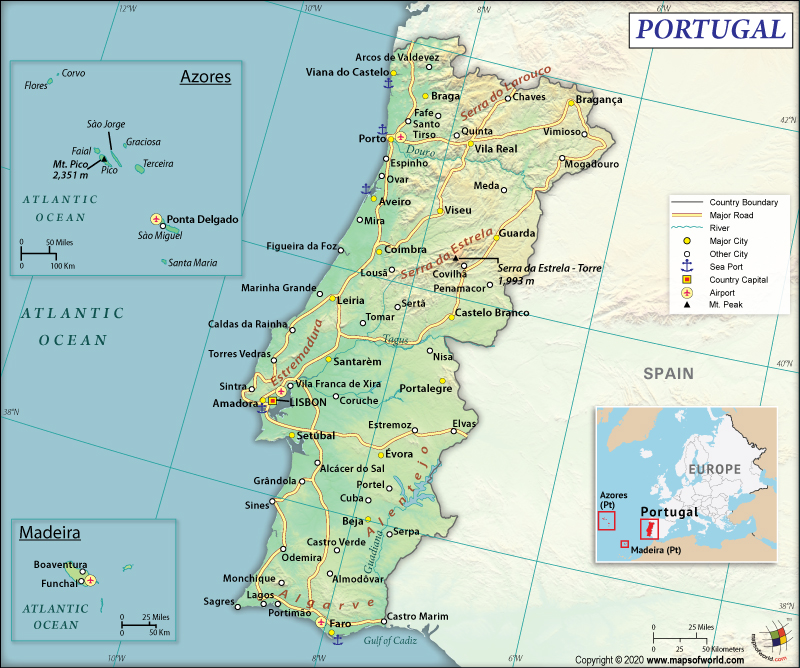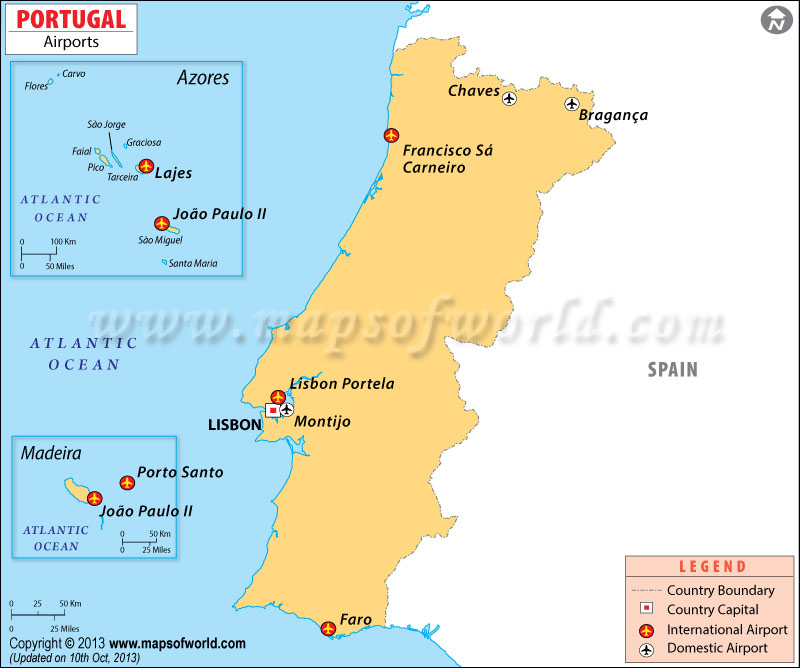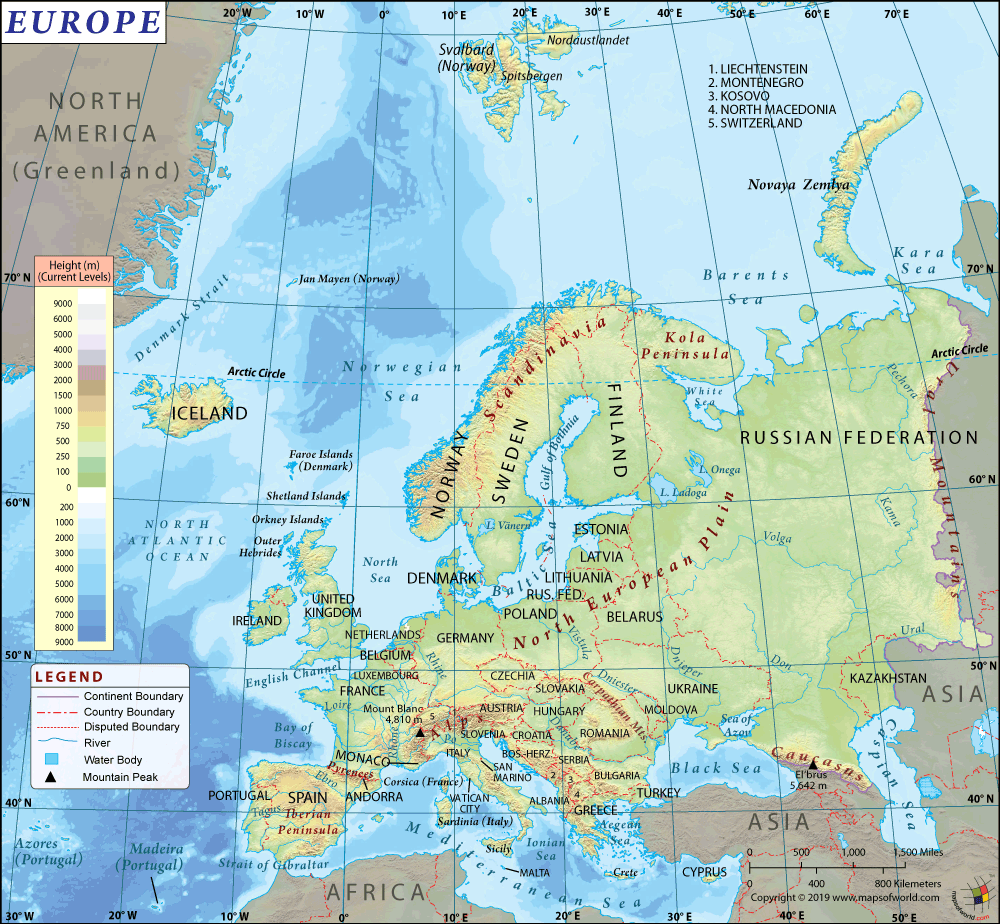What are the Key Facts of Portugal?

| Official Name | Portuguese Republic |
| Continent | Europe |
| Capital | Lisbon |
| Largest City | Lisbon |
| Coordinates | 38.716742, -9.133382 |
| Area | 35,603 sq mi (92,212 sq km) |
| Land Boundaries | 754 mi (1,214 km) |
| Coastline | 1,115 mi (1,794 km) |
| Currency | Euro (EUR) |
| Neighboring Countries | Spain |
| Population | 10,291,027 (2017 est.) |
| Official Languages | Portuguese |
| Major Religion | Christianity |
| National Day | 10 June, Portugal Day |
| National Anthem | “A Portugesa” |
| Form of Government | Semi-presidential republic |
| President | Marcelo Rebelo de Sousa |
| Prime Minister | António Costa |
| GDP per capita (PPP) | $32,554.3 (World Bank, 2017) |
| GDP per capita (nominal) | $21,291.4 (World Bank, 2017) |
| HDI | 0.847 (2017) |
| Literacy Rate | NA |
| Space Agency | Portugal Space Agency |
| Military Expenditure Ranking (SIPRI) | 43 |
| No. of Olympic Medals | 24 (as of 2018) |
| Driving Side | Right |
| Calling Code | +351 |
| Time Zone | Mainland Portugal, Madeira: WET (UTC+00:00)/ WEST (UTC+1, DST)Azores: AZOT/AZOST (DST) |
| Internet TLD | .pt |
Where is Portugal?
The Portuguese Republic is the westernmost country of Europe. It is situated in southwestern Europe on the Iberian Peninsula. It is bordered on the west and south by the Atlantic Ocean and on the north and east by Spain.
The Atlantic archipelagos of the Azores and Madeira are part of the Portuguese Republic. The country is named after Porto, the second largest city in the country.
What is the Geography of Portugal?
The Portuguese landscape is quite diverse, and changes dramatically from the northern region to the southern region. The west-flowing Tagus (Tejo) River divides the country: the north is mountainous with rocky hillsides, while the central part consists of pine forests, and a number of waterfalls and cliffs. The south is characterized by rolling plains suitable for cultivation and grazing. Further south, the Algarve region of coastal towns and beaches is a great tourist attraction due to its warm climate and distinct architecture. The population of Portugal is mostly concentrated along the Atlantic coast.
Minho, Douro, Tagus and Guadiana are the main rivers of Portugal, which all originate in Spain. Though Portugal lies in a seismically active belt, it has not experienced any severe earthquakes in the last 100 years. Serra da Estrela is the highest mountain range in Continental Portugal, with the highest elevation of 6539 feet (1993 metres). Mount Pico in Azores island is taller though, at 7731 feet (2351 metres).
The northern part of Portugal is colder and rainier than the south. Some parts even receive heavy snowfall in winters. The central part has milder climate, with moderate temperatures, while the southern region is warmer and drier due to the Mediterranean influence. At some places in Alentejo, the temperature can reach 40 degrees celsius in summers.
What is the Economy of Portugal?
Portugal has an advanced and high-income mixed economy, with emphasis on exports and the high technology industries. It is a developed country with a high Human Development Index, and was a founder member of the Eurozone. However, a financial crisis in 2011 forced the country to adopt austerity measures as part of a bailout package prepared by the European Commission, European Central Bank and the IMF in 2011. Though the country gradually recovered, it still has to tread with caution on the path of public debt reduction (125 percent of GDP in 2017). Most important trading partners of Portugal are the European Union countries of Spain, Germany, France, UK, US, the Netherlands and Italy. Service sector contributes (at 75.7%) the most to the Portuguese GDP. Industrial sector (22.1%) and agriculture sector (2.2%) contribute the rest. In recent years, exports and tourism revenue have aided the strong economic growth. The GDP (nominal) of the country is 239.473 billion dollars. The country exports agricultural products (including cork and wine), marble, chemical products, plastics and rubber, base metals, machinery and tools, textile materials and minerals to its trading partners while it imports vehicle and transport material, computer accessories and parts, semi-conductors and household goods. Portugal has also emerged as a leading Golf destination in Europe, bringing substantial revenue. The unemployment rate in Portugal gradually declined to 6.9% (World Bank, 2018).
What is the Transportation System of Portugal?
Portugal had 12 registered air carriers in 2015, with 64 airports. It has 3075 km of railways, and total roadways length of 82,900 km. Additionally, there are 210 km of waterways on Douro river. Lisbon, Leixoes, Setubal, and Sines are its major seaports.
What International Organizations is Portugal part of?
United Nations, ECE, FAO, IAEA, World Bank, ILO, UNESCO, UNIDO, WHO, NATO, WTO, OECD, African Development Bank, Asian Development Bank, Council of Europe, the Euro-Atlantic Partnership Council, the European Bank for Reconstruction and Development, the OSCE, and the Western European Union, CERN, Nuclear Suppliers Group and the European Union. It also has observer status in the OAS and the Latin American Integration Association (LAIA).
Related Links:



